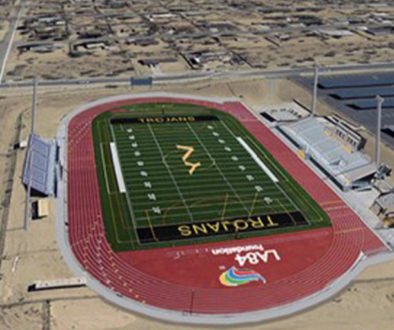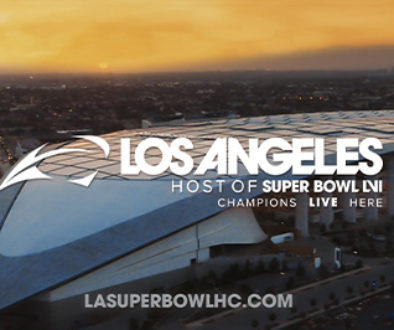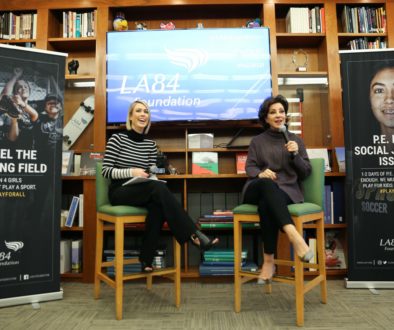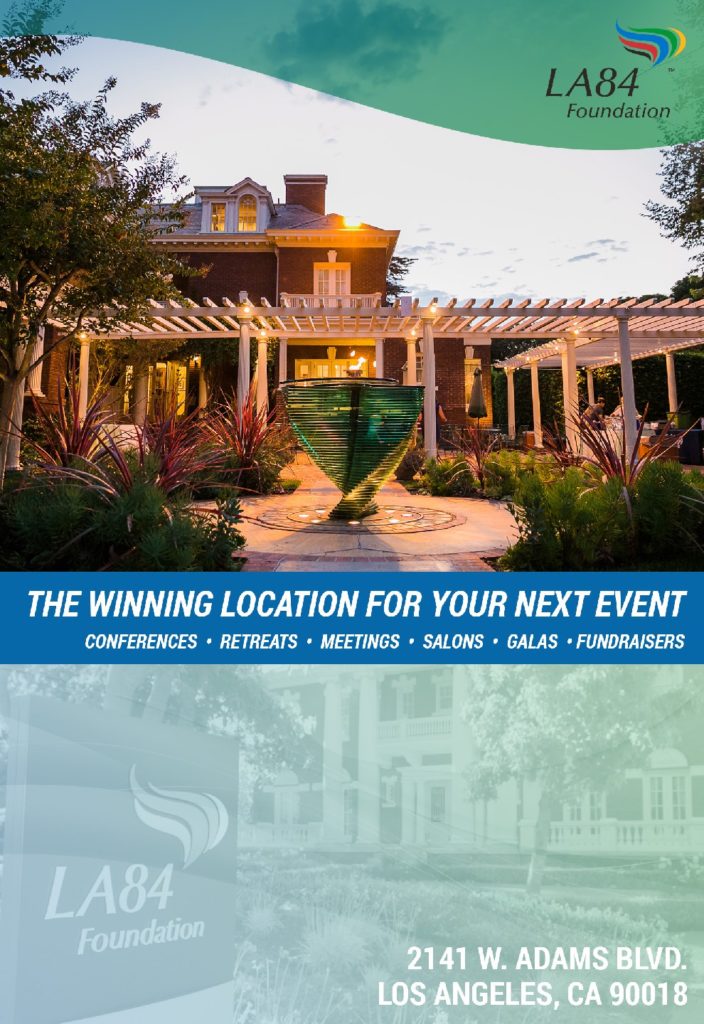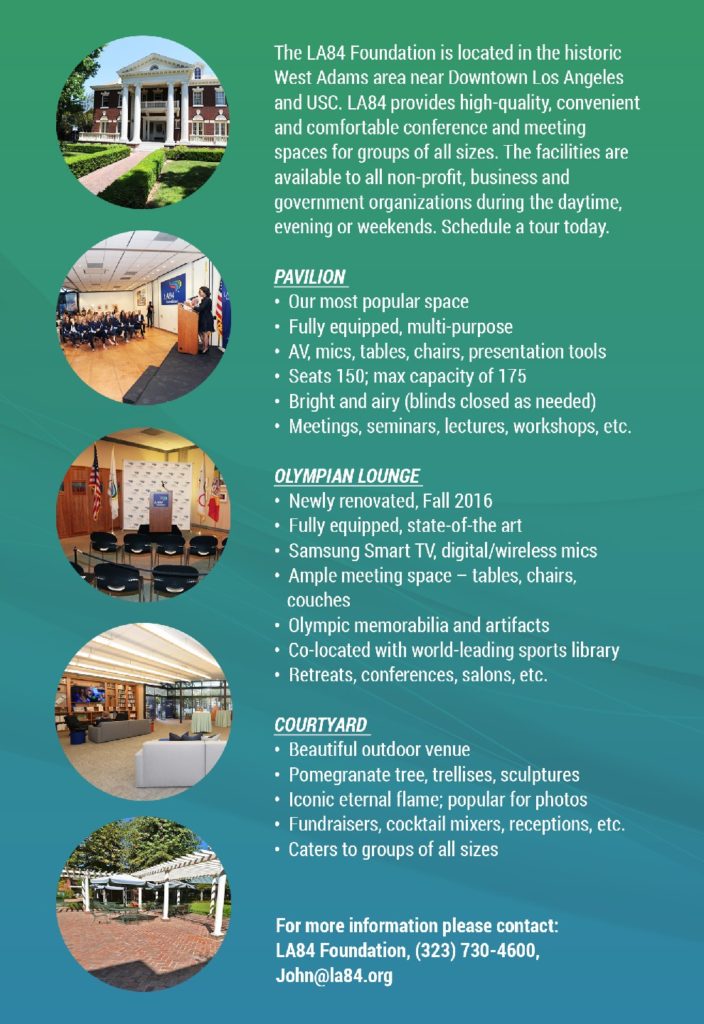SL Interview: Writer Doug Merlino’s Part in a Basketball Social Experiment
In 1986, when Doug Merlino was in the eighth grade, he took part in an experiment on and off the basketball court. Two fathers of boys on youth teams in the Seattle area – one of whom was white, the other black – decided to merge the players into one integrated squad. The adults hoped that the African-American youth would gain a chance at better educational opportunities and that the white kids would be exposed to an unfamiliar culture in their own backyard.
Merlino and his teammates from an exclusive private school soon found themselves playing alongside black kids from the central area of Seattle. The boys bonded, and the team ultimately won a league championship. After one season, they dispersed.
Two decades later, after starting his career as a journalist, Merlino decided to revisit his former teammates and discover what had happened to them in the intervening years. The result is “The Hustle: One Team and Ten Lives in Black and White” (Bloomsbury; Amazon), which recounts their youth basketball experience and assesses the well-meaning experiment that brought them together. Part memoir and part sociological exploration of race, culture and class, “The Hustle” examines the true meaning of youth sports.
A freelance writer living in New York City, Merlino has contributed to Slate, Wired and Men’s Journal. “The Hustle” is his first book.
SportsLetter spoke with Merlino from his home in New York City.
— David Davis
SportsLetter: Why did you decide to write the book?
Doug Merlino: The team was on my mind since 1991, when I found out that Tyrell Johnson [one of the African-American players on the team] had been murdered. I don’t know why it held my interest for so long, but it stayed in my mind. I started working on the book in late 2002, around the time when I felt I had the reportorial skills and maturity to start attempting to write about this.
SL: How did the murder affect you?
DM: From the start, the whole concept of this youth sports team was so idealistic, as far getting these two groups together, black kids and white kids. And then we went on and we were pretty good and won the championship. On the surface it was like a sports-movie thing.
After Tyrell’s murder, I started questioning a lot of what I had assumed was positive and good growing up in sports. I started questioning whether it had panned out that way or had just been that way at the time. So, I thought it would make for an interesting book.
Now, talking about the murder in the present, Tyrell came to symbolize this great lost potential. He was a beautiful kid who got killed so young.
SL: What did you expect to find when you started to track down your former teammates?
DM: Not what I found. I thought I would go back to Seattle and find everyone leading quote-unquote normal lives. I didn’t expect the disparity, from one guy being in jail to one guy running a hedge fund.
SL: What was it like to get back in touch with your old teammates, white and black?
DM: At first it was really strange. I was 14 at the time we played together on the team, and I had dropped out of touch with both sides of the team, especially after high school. Seeing some of the guys that I’d gone to school with – the white guys and Eric Hampton [an African-American student at Merlino’s school] — brought me back to being that age, with all these insecurities and memories that I had totally forgotten about. So, that was weird. Catching up with some of the black guys was interesting in another way because, back in the season I write about in the book, they had to generally come to “our side of town.” It was cool to flip it around and get to know those guys better and see their lives.
SL: When you and the other guys on the team were growing up in Seattle, was it a segregated city?
DM: Totally. I grew up in a neighborhood that was almost all white. Our family had moved to the suburbs when I was really young, and when I asked my mom about that she told me it was to get away from busing. I went back and looked at the numbers from my public elementary school: there were 327 kids – 315 of which were white, nine were Asian, one Native American, and one or two black kids.
Growing up, central Seattle was where all the black people lived. That was their neighborhood. When I started researching how that happened, I found that the neighborhood had been created through purposeful segregation. It was impossible for black people to buy houses or rent apartments in other parts of town until 1970 or so, when it started loosening up. So, it was extremely segregated, and what I learned was: the segregation wasn’t by accident. It was planned.
SL: Back in 1986, when this youth basketball team was put together, you were a student at Lakeside School, which is now famous because Bill Gates went there. How would you describe the school?
DM: I didn’t realize it when I started going there, but Lakeside is probably the most elite school in Seattle. It was started in the 1920s for the leading businessmen to send their sons to so they could get this East Coast, boarding-school type education. Over the years it’s maintained this status, although it has evolved. Besides Bill Gates, the Nordstrom kids went there, the Weyerhaeuser kids went there, the sons of the guy who owned the Seattle Sonics went there.
When I started there in fifth grade, we had 32 kids in our class. The one black kid was Eric, who was on the basketball team with me. Over the years they added a few more African-American kids.
SL: You write about a chant that Lakeside students used at the school’s sports events against their opponents: “It’s all right, it’s OK, you’ll all work for us someday.” What was that about?
DM: It’s funny because, when I was a student there, one of the teachers had us talk about that exact chant in our class. I remember saying something like, “That’s one of the reasons why people think Lakeside kids are so snobby.” And everybody was like, “That’s nothing. Don’t take that seriously.”
I had forgotten all about it until Damian Joseph [one of the kids on the team] brought that up in an interview. He came from the other side of the race and cultural divide from Lakeside, and his point was, “It was harsh, but it was people telling the truth. Look how things have come along.” That quote was a turning point in the whole reporting process for me.
SL: When you were first put together with the black kids, what was your reaction?
DM: When these guys came to play, I was pretty excited. I was a pretty mediocre basketball player, so I already knew I wasn’t going to play much. But I thought it was cool that we could have this team. I guess I was more interested in the whole social dynamic because it was so different than the everyday thing at school. I give a lot of credit to Randy Finley and Willie McClain, the two adults who organized the team. In general, they didn’t make any big announcements about it or anything.
SL: How would you describe those two, Willie McClain and Randy Finley?
DM: I think of them as a product of their times. You have to look at them through the lens of the 1960s, with the idealism they had. Willie McClain was born in Gulfport, Mississippi, in the old slave quarters, totally segregated. He moved to Seattle in 1960 and went through the whole Civil Rights Movement there: he’s out on the streets during the whole 1968 riots and essentially lives his whole life in the central area, in segregated Seattle. By 1986, when he forms this youth basketball team, he’s been saved and gotten his life on track and taken on a lot of the integration spirit of the ’60s.
Randy Finley is the son of a state Supreme Court judge. He went to University of Washington during the 1960s and had this adventurous spirit. He motorcycles through Mexico and sells trinkets at rock concerts. Eventually, he becomes this successful businessman and builds up this successful chain of art-house movie theaters. But the ’60s ethos never leaves him.
SL: What were their motives for merging the two teams?
DM: Trying to make a change, trying to do good things. They had this goal of integration, that this would change kids’ lives for the better. They wanted a better life for the boys on Willie’s team, and that meant getting access to the better schools, to a better education.
At the same time, they’re both very competitive, driven men. They love basketball and want to win basketball games. I think that was part of their motive, too.
SL: Did you feel like you were part of some sociological experiment?
DM: I think every kid on the team would have a different answer on that. For me, I knew from the start that it was something bigger than your normal basketball team. They had us do these different these things – like have us watch movies and have sleepovers, where they were obviously trying to get us together more.
SL: Did you guys mix much off the court?
DM: It was all the stuff that Randy and Willie had set up. There were a few sleepovers and watching movies after practice. It was all organized by those two.
SL: You write in the book about the concept of true integration versus surface integration. Was the team an example of true integration or surface integration?
DM: That was a quote from Damian, and I agree that the experience was probably more surface integration. It was about what was happening on the court and about basketball, and not much else. It only went so far. A lot of the stuff I get into in the book — as far as the racial history of Seattle and what was going on politically and in the school system – was probably a little too heavy for a bunch of 14-year-old kids.
SL: You write that the black kids always came from central Seattle to the north side of town, to where the white kids lived, and not vice versa. Why did that happen?
DM: I thought about that quite a bit. For whatever reason, the Lakeside kids didn’t go down to the central area to play sports with the black kids. Years later, it’s almost impossible to untangle why people were doing what they were doing. You have hindsight and you have gaps in memory. But I think it was an unspoken thing between Randy and Willie to bring the black kids to the north. I think there was the perception that Willie had a lot more to gain potentially by bringing his kids out to the private schools in that maybe he could get scholarships for them. I also think there was some nervousness about bringing us to the central area, for whatever reason. It just didn’t happen.
SL: As a kid, what did you learn about black Seattle?
DM: At the time, I don’t think I learned anything intellectual. It was just, these are some nice kids and we’re having fun playing basketball together. It was totally unlike my community-league football games, which got nasty and there were a lot of bad feelings.
SL: Do you think Willie McClain and Randy Finley got what they wanted from the team?
DM: I think at the time they would say yes. Now that I’ve done the book and researched what happened to everyone, it’s more complicated. I know both of them have thought more about it.
Back then, three of the kids on Willie’s team – his son Willie, Damian Joseph, John Thompson – got scholarships for private school. Willie and Damian went on and got into college. So, that was great for them because it’s very possible that neither of them would have been able to get this education and go to college without that experience.
With Randy, I think he got what he wanted at the time, in terms of helping the kids get into better schools. But the overall results have been very imperfect.
SL: You write that, after your team disbanded, Randy Finley did that fulltime for a while – that is, helping disadvantaged kids gain access to better schools. How did that pan out?
DM: For about two or three years he was going around and working to get these kids into good schools. He took on a lot more kids than just the kids on our team – 17 in all. That’s his personality: it’s always full speed ahead. Eventually, it got to be too much for him because the kids needed a lot of support, educationally and just in making the transition. He burned out on it. Looking back, trying to take kids who don’t have the same educational background and family money and support and sticking them in elite private schools is very difficult. In hindsight we see that.
SL: When you went back and met your old teammates again, what did you find?
DM: There’s a couple of people that you can point to and say, Randy and Willie directly made a difference. The first example is Damian Joseph, who got into private school through this thing, had his ups and downs but got through it, and then got into college. Now he’s a teacher and doing great. Will Junior, the coach’s kid, got into private school, got into college. He didn’t finish college, but when you talk to him today he says, “Without that team, who knows where I’d be.”
I guess the other person that this had a big impact on is me. When they organized the team, the idea was to make some lasting connections. I spent eight years writing a book about us, and interviewing everybody, so I guess it did have a long-term, lasting impact.
SL: In the book, you cite Michael Messner’s writings about how kids from different backgrounds transition from youth sports to the next stage in life. With your old teammates, what was their experience with transitioning from youth sports?
DM: Michael Messner’s work about transitioning was really powerful, and I found it really helpful. He conducted this interview study with athletes from different racial and economic backgrounds. What he found was that boys from every background generally started playing sports because a male role model – usually, their dad – introduced them to it, and this was a way of bonding with male authority figures. They all joined teams and found in sports a sense of structure and purpose, and this became part of their identity.
When the kids start to move on in life, Messner found that kids with better economic opportunities, kids with more advantageous backgrounds, start looking at college and, down the line, careers, even if they’re very involved in sports. That transition occurs gradually. Their identity as this “sports person” fades away to the background as they move on to something else.
This played out with the Lakeside guys, with the kids from white and wealthier backgrounds. You can see a fairly orderly progression from youth sports through college and then careers and adulthood. It wasn’t perfectly linear, but they were able to move on from their identity as this sports person to something else.
Whereas, Messner found that kids who came from poor backgrounds were not getting lined up for college because their whole identities had been built on sports. When the sports ended, there was nowhere to go. That was especially powerful because that happened with so many of the black guys on the team from the central area. Our coach, Willie McClain, was a star athlete back in the late ’60s. He’d gone to community college, and he could have gone on to play Division I football. But he didn’t really know what he was doing. Once he dropped out of community college, he had nowhere to go except to the streets. He’s truly a wonderful man now, but he said that for about five years he was going nowhere.
The pattern repeated with his son, who went through the same thing after playing football for a while at Boise State. He was lost after sports. And, that happened with almost all the guys on the team who came from really poor backgrounds. They had difficulties transitioning out of sports to something else. They told me that basketball was completely what they did; the team they played on was their family. When that ended, they struggled. Some guys eventually found their way. Other guys fell totally by the wayside.
SL: Having gone through this, do you think youth sports is a useful tool in breaking down barriers of race and class?
DM: That’s one of the main questions that I keep turning over in the book. In one sense, yes, because it’s hard to imagine any other way of bringing these kids together except through basketball. Youth sports can be an awesome vehicle for getting people of different backgrounds together and building relationships in those formative years. I’ve heard from a lot of people who’ve read the book telling me that they had experiences similar to mine, with friendships that they made as kids that have continued as adults.
And, I don’t know if what we went through would’ve worked if we’d been talking about history club. Basketball was something that every kid, regardless of his background, was passionate about. We went to play basketball because we liked to do it. In that sense, it was very useful in bringing these two different cultures together.
On the other hand, if things are just about what’s happening on the court, you can start to fool yourself. If you say, it’s integrated on the court, therefore everything’s fine, you’re missing something. As I point out in the book, sports has its limitations.
SL: What you write about happened in the mid-1980s. How has youth sports, and youth basketball, changed?
DM: A lot. This was not the hard-core AAU experience that George Dohrmann writes about [in “Play Their Hearts Out”]. It might have been in other places, but in western Washington, it was totally mom-and-pop. It was, like, you just got to play on the weekend.
Today, it’s totally different. It’s one thousand percent more organized, and there’s been a bunch of NBA players that have come out of Seattle. You still have white AAU teams and black AAU teams in Seattle. The difference is, there’s no pretense toward integration. It’s just about winning.
SL: Is there a middle ground for youth sports?
DM: The hard part is figuring out the mission of youth sport. There’s this tension, and it seems to be getting more pronounced: are we doing it for this James Naismith ideal of becoming better people and learning discipline and skills and learning to work together or are we doing it because we want to go to a D-I school? That’s the core tension.
It’s a pity because the vast, vast majority of kids who play youth sports are not going to go any further than that or maybe high school. It seems like you could have teams like ours, with a more expressed social purpose, and it would be good for everyone.
SL: In terms of writing “The Hustle,” were there any basketball books or other works that influenced you?
DM: I read a lot of basketball books, but the one book that I really found useful was Michael Sokolove’s “The Ticket Out,” about Darryl Strawberry and his [Crenshaw] high-school baseball team in L.A. He used a similar structure. I also liked the “Seven Up” documentary films [directed by Michael Apted].
